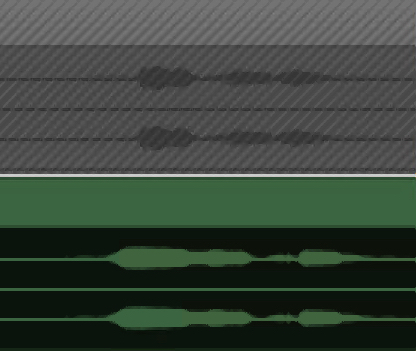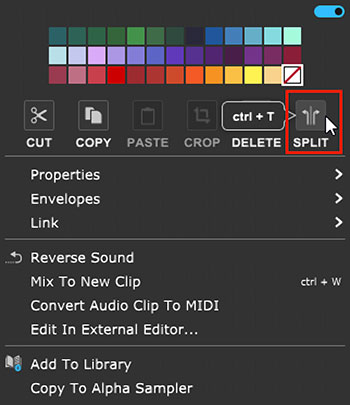STUDENT’S GUIDE | |
MIXLIBS PROJECT | |
NAME: | |
CLASS TIME: | |
PERIOD: | |
TEACHER: | |
CLASS: |
REQUIRED MATERIALS:
Mixcraft Mixlib Session Files (“Additional Materials Download”)
Computer with Mixcraft
Student Guides (“Additional Materials Download”)
Microphone (Built-in or External)
SUGGESTED MATERIALS:
Headphones
External Microphone
Microphone Cable
Microphone Pop Filter
Audio/Computer Interface
Blank CDs for burning Mixlibs
ACTIVITY
Open Mixcraft and select the Mixlib session file or double-click on the session files moved to the desktop. Mixcraft will load the Mixlib project. If you do not know the location of the Mixlib session files, ask your teacher for help. Once the session is open, you should see two audio tracks on the Timeline – one with recorded audio and one with no audio.
 The Mixlib session file, Mixlib_Journey, is now loaded.
The Mixlib session file, Mixlib_Journey, is now loaded.Recording Audio Setup. To prepare for the recording of audio, ensure that the microphone and audio/computer interface are properly set up. Again, you may need your teacher’s help during this setup.
First, to prevent feedback, turn off any speakers or monitors. If possible, use headphones while recording. Connect headphones to the headphone jack on your audio/computer interface, or on your computer.
Next, connect the microphone to the audio/computer interface with a microphone cord. To make sure Mixcraft is monitoring the audio/computer interface, check the File > Preferences > Sound Device tab and make sure the proper interface is selected. If using a microphone pop filter, place the filter in front of the microphone. This will help create clean vocal recordings.
Testing the audio signal chain.
Arm the second audio track in the workspace (right below the audio track named “story”) by clicking “arm.” The downward arrow next to the arm button will enable us to select the source of your recorded audio. Make sure your interface is selected. To check speak into the microphone – you should see the volume meter jump.
TIP: Don’t forget to wear your headphones to hear what is being recorded.
Remember: For clean recordings, monitor the incoming audio on the audio track’s volume meter. You want to record in the “yellow” zone. In this zone, your recordings will be audible, but not so loud that you will add junk to your recording.
 If the meter is reaching the “red” area, try dialing back the gain on your audio/computer interface or move farther away from the microphone.
If the meter is reaching the “red” area, try dialing back the gain on your audio/computer interface or move farther away from the microphone. Careful! Recording in the “red” zone could be harmful to your equipment or ears and could distort the recorded audio.
Careful! Recording in the “red” zone could be harmful to your equipment or ears and could distort the recorded audio.
The markers (the flags) denote the gaps in the Mixlib. Each flag offers a clue about the word you should record in the blank area of the track.
 The orange flags divide the Mixlib into sections. Record your words right after the flag markers and stop before the waveforms.
The orange flags divide the Mixlib into sections. Record your words right after the flag markers and stop before the waveforms.TIP: Zoom in using the magnifying glass icon or by hitting the “+” key to get a closer look at the markers.
Ensure the first audio track (the story track) is muted before recording. Remember you are not supposed to hear the story until the Mixlib is completed. No cheating!
Double clicking a flag marker aligns the play back cursor with that section of the Mixlib. This means recording will also start from this position.
Record. With the second audio track armed, click the master record button (outlined in red) or the R key and try to record a word right after one of the markers.
 The red circle is the master record button.
The red circle is the master record button.Stop recording by hitting the space bar or the master record button again. Play back the recorded word and check for artifacts, distortion, or other unpleasant sounds that may have been recorded. If you need to record you word again, simply click on your recording and hit “delete” on the computer keyboard.
 Recording a Mixlib: The top track is muted as to not play back the story, while the bottom is being used for recording. Each word is recorded right after the markers.
Recording a Mixlib: The top track is muted as to not play back the story, while the bottom is being used for recording. Each word is recorded right after the markers.Continue recording and finish filling in the Mixlib. Try to come up with imaginative words for your story.
Once this task is completed, deselect the mute button of the “story” track. Both tracks will now be audible. Rewind and play back the Mixlib. Listen for parts that may need editing: are some words too isolated? Does the story sound like a continuous narrative?
If the Mixlib needs editing, “trimming” and “splitting” the recorded audio into individual regions is a useful strategy to arrange the Mixlib on the Timeline:
Trimming audio: To trim audio or to shorten/extend recordings, move the cursor near the ends of an audio region (but not on the region’s horizontal center line) until a double-sided arrow appears. Simply click, and drag left or right to set the audio region to the desired length.
 An audio region with excessive silence.
An audio region with excessive silence. The beginning of the audio has been trimmed closer to the attack (beginning of the tone) of the waveform, making it easier to line up this region with the rest of the story.
The beginning of the audio has been trimmed closer to the attack (beginning of the tone) of the waveform, making it easier to line up this region with the rest of the story.Splitting audio: To move audio regions, it is best to cut up the recording into segments. Right click an area on an audio region and select “split” (Ctrl + T). The region will now be cut into two pieces. The region can be cut into as many segments as necessary. Grab and move the regions on the Workspace to rearrange the recording.
 Splitting audio regions is easy. Simply right click and select “split.”
Splitting audio regions is easy. Simply right click and select “split.”Once the recorded audio regions have been tidied up, arrange the regions to match the rest of the story. Use the waveforms as reference points. Place your words right after the flag markers and close to the waveforms on the “story” audio track.
To merge the segments, select them all and “merge” (Ctrl + W).
Sharing. Notify your teacher that you have finished your Mixlib. Have your teacher listen to your creation.
With your teacher’s approval, mix down the story to a file on the computer. Go to the Menu and select File > Mix down to… > .MP3. Name and save your Mixlib on the desktop.